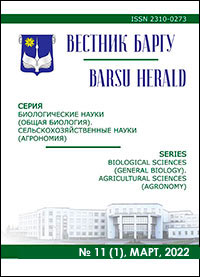ECOLOGICAL STRUCTURE OF TERRESTRIAL MOLLUSKS (MOLLUSCA:GASTROPODA, PULMONATA) OF BEREZINSKY BIOSPHERE RESERVE
Keywords:
Berezinsky Biosphere Reserve; protected natural areas; species composition; terrestrial mollusks; ecological groupsAbstract
The spectrum of ecological groups of terrestrial mollusks in different biotopes of Berezinsky Biosphere Reserve has been analyzed. It was revealed that the most part of malacofauna consists of miceto-saprofagous species,
which inhabit forest litter. This group of mollusks includes mesofilic and psihrofilic species. Members of several ecological groups have general features of shell morphology.
On the basis of the spectrum of the ecological groups of terrestrial mollusks the investigated biotopes can be divided into five groups: alder end spruce forests, oak forests and willow forests, meadows, birch forests and pine forests.
Unlike other biotopes, pine and birch forests are characterized by significantly depleted spectrum of ecological groups of mollusks.
Alder and spruce forests are characterized by predominance of polytopic species, such as Helix pomatia, Eoumphaliа strigella, Arion subfuscus. At the same time in this types of biotopes the part of miceto-saprofagous
species decreases. Wet flood-plain oak forests and willow forests are marked by predominance of psihrofilic inhabitants of leaf litter. Meadows and birch forests are characterized by the depletion of the spectrum of the ecological
groups of mollusks.
Fig. 14. Table 2. Ref.: 11 titles.
Downloads
Published
Issue
Section
License
Copyright (c) 2023 Вестник БарГУ Серия "Биологические науки. Сельскохозяйственные науки"
Это произведение доступно по лицензии Creative Commons «Attribution-NonCommercial» («Атрибуция — Некоммерческое использование») 4.0 Всемирная.
Авторы сохраняют за собой право заключать определенные договорные соглашения, касающиеся неисключительного распространения опубликованной версии работы (например, размещать ее в институциональном репозитории, публикация в книге) со ссылкой на ее первоначальную публикацию в этом журнале.





